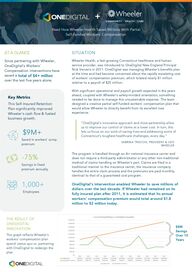
Return to flip book view
"OneDigital's innovative approach and close partnership allowus to improve our control of claims at a lower cost. In turn, thislets us focus on our work of saving lives and addressing some ofConnecticut's toughest healthcare challenges, every day."SABRINA TROCCHI, PRESIDENT & CEOWHEELERWheeler Health, a fast-growing Connecticut healthcare and humanservice provider, was introduced to OneDigital New England PrincipalNick Ververis in 2011. OneDigital was managing Wheeler's benefits planat the time and had become concerned about the rapidly escalating costof workers’ compensation premium, which totaled nearly $1 millionrelative to a payroll of $25 million. SITUATIONKey MetricsThis Self-Insured RetentionPlan significantly improvedWheeler's cash flow & fueledbusiness growth.-75%Savings in fixedpremium annually$9M+1,000+Saved in workers' comppremiumEmployees+AT A GLANCESince partnering with Wheeler,OneDigital’s Workers'Compensation interventions havesaved a over the last five years alone. Read How Wheeler Health Saved Millions With PartialSelf-Funded Workers' CompensationWith significant operational and payroll growth expected in the yearsahead, coupled with Wheeler's safety-minded orientation, somethingneeded to be done to manage this unsustainable expense. The teamdesigned a creative partial self-funded workers’ compensation plan thatwould allow Wheeler to directly benefit from its excellent lossexperience.OneDigital’s intervention enabled Wheeler to save millions ofdollars over the last decade. If Wheeler had remained on itsfully insured plan after 2011, it is estimated that its annualworkers’ compensation premium would total around $1.8million to $2 million today.The program is handled through an A+ national insurance carrier anddoes not require a third-party administrator or any other non-traditionalmethod of claims handling on Wheeler's part. Claims are filed in atraditional manner to the insurance carrier, the insurance companyhandles the entire claim process and the premiums are paid monthly,identical to that of a guaranteed cost program.THE RESULT OFONEDIGITALINNOVATIONThe graph reflects Wheeler'sworkers' compensation planspend: status quo vs. partneringwith OneDigital to redesign theplan.total of $4+ million$8MSavingsOver 10Years
Beginning in 2011, Wheeler agreed to a $250,000 per claim deductiblewith a $700,000 total stop loss for all claims. Its annual premium wasfixed at $215,000, compared to $900,000 under a fully insured plan.This transition significantly improved the organization’s cash flow andallowed Wheeler to fully benefit from its excellent loss experience. APPROACHWhat is a partial self-insuredworkers' compensation plan?In this arrangement, thecustomer pays a low fixedmonthly premium and agrees toa deductible level per claim anda total loss stop per year for allclaims. Claims are filed in atraditional manner, and theinsurance company handles theentire claims process. Inaddition to the monthly fixedpremium, the insurancecompany will invoice for theactual paid claim amountsmonthly. The insurance companyprovides loss control and a fullcomplement of claims servicesand reviews designed accordingto the client’s needs. As projected, Wheeler grew rapidly in the years following 2011, withpayroll skyrocketing from $25 million to $55 million – an incredible featfor the business. Because the partial self-insurance plan was in placeduring this scale-up period, Wheeler was able to realize enormoussavings and reinvest them into other aspects of the business. Over theyears the fixed premium rate remained constant and did not increasedramatically.Year 1Years 2-10TodayThe fixed-rate premium in Wheeler's new workers’ compensationpolicy typically sees an annual increase of less than 2%, the nonprofitinstitution continues to benefit from a plan structure that has scarcelychanged since 2011. Wheeler's story is not uncommon, but it requires partnering with a trusted team offierce advocates who put the best interest of your business and your people, first. Relyon a data-based, proactive approach to safeguard your people and your business. Learn more at: OneDigital Property & Casualty.Today, 12 years later,Wheeler has a$350,000 deductibleand $900,000 stoploss aggregate, as wellas a premium paymentthat is almost 75% lessthan a fully insuredprogram.A self-insured retention planworks best when the client has: $500k of premium on a fullyinsured basis; this is industryanalogous. Loss experience which hasbeen reasonably good for theprior 3 years. Experience modificationfactor of less than 1.20typically.1.2.3. OneDigital's WorkforceCompensation interventions havesaved Wheeler a total of $4+ million over the past five years alone.AT A GLANCEGiven Wheeler's good loss experience for the past three years, thecompany has paid a total of approximately $1.35 million for all workers'compensation costs, whereas the fully insured plan would have likelycost more than $5 million. With the company’semphasis on a safe workenvironment for all, claims have averaged well below the deductible or stop loss amounteach year since 2011.